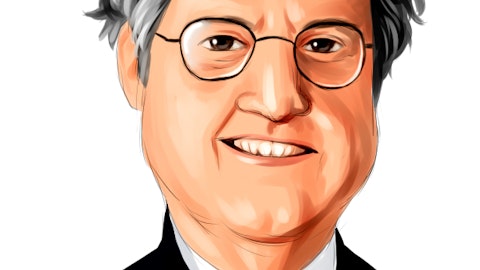Dale Gibbons: Yeah. I would look for something in kind of the mid-50s. We were 54% for the first quarter as you saw there. There were some seasonality in costs, which we talked about a little bit primarily related to compensation and FICA. But we do believe that we can get that number back to the beginning with a four again. And — but we would hope to have better performance, I think that was much stronger from AmeriHome in that process. We do think that there’s a significant kind of pent-up demand with AmeriHome and that there’s a lot of people that do want to move out of their house, but they’re kind of — they’re in love with their mortgage rate presently. As the — when we have that hit down at the FOMC commentary after this CPI in January that it really kind of came back and we saw a lot more activities and saw that in our numbers.
So with that, on the denominator side, more steady situation on the numerator side regarding their ECRs, we think that number can trail down over time. But for now, I keep it in the mid-50s.
Kenneth Vecchione: Casey, on the FDIC special assessment, that’s not in our numbers and our guide and our adjusted efficiency is going to be in the low 50s as we work that down towards the high 40s, but that’s what I would say, okay.
Casey Haire: Great. Thank you.
Operator: Thank you. The next question comes from the line of Steven Alexopoulos with JPMorgan. Steven, please go ahead.
Steven Alexopoulos: Hi, everybody. I want to start…
Kenneth Vecchione: Steven, can you get a little closer to the phone. You’ll probably get muted.
Steven Alexopoulos: Yeah. Could you hear me now?
Kenneth Vecchione: Much better. Thank you.
Steven Alexopoulos: Okay. So let me start on the deposit side. Ken, I thought you said, you thought you could grow deposits $2 billion per quarter. Is that right because that would take you above the $11 billion for the year?
Kenneth Vecchione: Well, on average, $2 billion a quarter, but Q4 is a little softer as you’ve seen last quarter where the warehouse lending deposits roll out. So we think that’s more of a private guide. Basically, we’re just trying to tell you — think about the end number of $11 billion is where we think we’ll end up.
Steven Alexopoulos: Got it. Okay. It’s funny, Ken. I’ve asked you, I don’t know, maybe two or three calls in a row. Once you get to your targets, how should we think about Western Alliance and growth desire appetite, where you could be long term. So if we think about if we average this out, you’ll probably one $2 billion, one $3 billion (ph) per quarter loans and deposits run rate, so call it $5 billion per year for each. Is that about adjusting for the loan-to-deposit ratio, is that how we should think about this now that you’re at target, maybe that $5 billion-ish growth per year balance sheet?
Kenneth Vecchione: So we’ve got a number of levers to pull and we have a great deal of optionality. So first thing I’d say is, the way we’re thinking about it is, from here, whatever liquidity we bring in, whatever deposit growth we bring in, we would like to put out at about 80% loan-to-deposit ratio. So we could stay between that 80% to 85% level. And that’s what we’re going to try to target going forward. It will take a little time to build up that loan growth engine because obviously, if we’re telling you $2 billion in deposits and $1 billion in loans, that’s not 80%, but we’re getting that back up again. You’ve got to get the deals done. You’ve got to get it documented. You’ve got to have clients put their cash in before we put our funding in, and that will just build up as we go throughout 2024 and into 2025.
And then if we do better than that, meaning a higher deposits or the loans stay in that $1 billion-plus range, then we’ll use some of that incremental liquidity, and we’ll use it to pay down borrowings, and that will also mute the growth of the balance sheet. Dale, do you want to add anything to that?
Dale Gibbons: Yeah. I mean to say it another way, I expect that we can exceed those numbers, Steve, a bit because we’ve been paying down borrowings coincident with growing deposits faster than your $5 billion a year number.
Operator: Thank you. The next question comes from the line of Chris McGratty with KBW. Chris, please go ahead.
Chris McGratty: All right. Good morning. Ken, Dale, it feels like the $100 billion has obviously got a ton of attention. It feels like you’ve more or less addressed every piece of it. Obviously, there’s ongoing regulation, but liquidity expenses, capital is that a message you’re trying to send with the last actions over the last few quarters?
Kenneth Vecchione: Yeah. So we are taking actions today and preparing to cross over $100 billion in a few years, okay? The improvements we’ve made in our risk management architecture, both on capital analysis, liquidity analysis and planning indicated to us that it was better to build that liquidity reservoir early on, and we wanted to get that done and we’ve accomplished that. The other thing was let’s get capital out of the way. We think 11% around that number is the right number going forward, so we’ve done all that. But behind the scenes also, Chris, is a lot more in risk management build that has to occur, that’s been basically built into the company over the last couple of years. So where we are today, we’ll say we’re about 75% of the way to us being ready to be $100 billion.
$100 billion is just a number for us. We’re not looking to get there sooner. It all depends on, again, the economy and the opportunities that we have in front of us. But what we don’t want to happen is we don’t want to be stopped when we hit that level. So we want to grow in an unencumbered way. In the meantime, the risk architecture that we’re putting into the company is paying dividends and somehow a return and how we think and manage the company. So we’re happy that we’re doing that as well.





